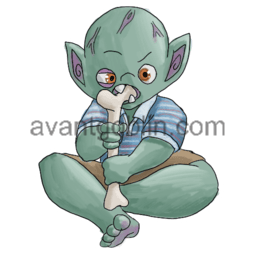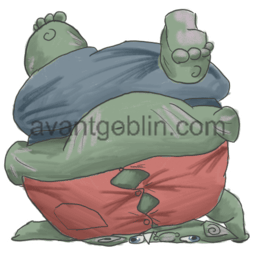What is a Goblin?
The common word "goblin" is often used to mean "horrible little beast" of some kind, and can refer to everything from cats to demons, but we all know that there is a specific type of beast most commonly meant by the word.
That particular use of goblin is, according to the author/illustrator Jack Verdis, a "small little green dude with pointy ears and teeth, usually up to shenanigans." More specifically, a goblin (as far as this collection is concerned), is one of the green and friendly-looking creatures that populate the pages and margins of this content setting. They possess round, rather protruding eyes that can look in two different directions at once; pointed ears that rather resemble a cat or a bat for the most part; three fingers and a thumb per hand, and four toes per foot; a non-specific number of teeth that tend to protrude from the mouth; come in nearly every shade of green; and are in general a bit squishy. Their skin texture is primarily slightly fuzzy, but with distinct sticky pads on the hands, feet, nose, inner ear, and especially tongue; notable by the lessening of fuzz and increasing of sticky mucous, usually visible by way of a coloration shift. Goblins do not have bones, which is thought to be an adaptation brought on by their love of being thrown (for evil emphasis or just in general), and to avoid the sorts of adventurers who steal bones for nefarious uses; but they do have enough cartiledge and gristle to walk upright and function as a mostly-humanid form. Partially due to the not-having-bones, a skinny goblin is a very unhealthy goblin, and even an underweight one will just be a bit willowy rather than notably angular; and their fat distribution can and will accumulate all the way to forming a near-sphere. Gender is not really a concern, often has very little to do with visible morphology, and has little to no effect on reproduction. Goblins are indeed, in short, "just a little guy."
Goblin Variants
Goblins do come in a variety of shades of green, with many colors of irises and sticky pads ranging from grey-violet through rose and into peach. They may be taller or shorter, more willowy or just chunky, or have any or all combination of what humans would consider dimorphic sex characteristics.
While most goblins do not have bones, hobgoblins (as they are known by outsiders) do have bones. Their shape and gender presentation is more closely aligned with humans, though they will also have the fuzzy green skin and sticky pads. Their ears appear a little more proportional and side-aligned to the head, which has a skull. Most of these can ascribe their ancestry to half-breeding, often with humans or something else with a logical bone structure. They're also useful for keeping track of smaller goblins in more strategic settings, being on average a bit smarter, likely due to having a skull.
The other major skeletal variant is often known as bugbears, which are quite easy to mistake for orcs or other true battlefield muscle tanks, but are in fact just goblins. The difference is that bugbears have entirely too many bones, from unknown or illogical sources, often resulting in alarmingly long arms, extra fingers, additional joints, or strange stances. Legally, Edna is one of these.
All skeletal (and non-skeletal) variants of goblins are easily able to survive catastrophic injury with proper care, or even non-catastrophic aging with aches and pains, and will readily fashion or steal, and use, mobility devices and lifestyle aids.
Goblins make little distinction between any of these. All goblins are accepted among goblin-kind, plus anyone else who can handle the lifestyle (more on that later). Bugbear and hobgoblin are antiquated war terms to do with distinction on the field, but still referred to in some settings for bone care reasons.
Culture, Care, and Concerns
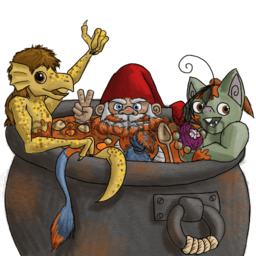 |
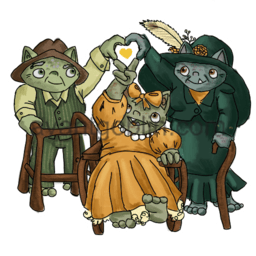 |
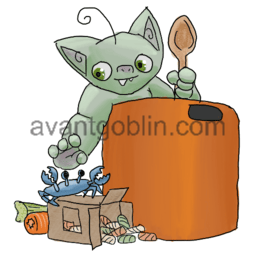 |
Acquiring Additional Goblins, and Caring For Them
Contrary to popular belief, goblins are not mushrooms or fungus. Mushroom pygmies are absolutely fungus, and behave such, but not goblins. Goblins are soup!
To create additional goblins, one will need one or more goblins, a large enough pot to contain those goblins plus some extra, a heat source, and a guide and ingredients to a soup recipe ("soup" can be considered anything with both liquid and chunks. The debate of "what is a sandwich" will be published later). A quick battlefield soup can be as simple as hot water, stolen bones, and a few sticks and leaves; but this tends to produce fragile, stupid, and chaotic goblins. Goblins made with care will have an edible and delicious soup recipe, and will in turn have a depth and personality to match. Prepare the soup as directed on the recipe, allow to simmer down to a bathwater or hot tub temperature, and allow goblins to sit in it. More goblins can be acquired from the bottom of the pot. These new goblins are deliberate, and can only be created with consent of at minimum one party within the soup pot - certain evil overlords may find a need to apply themselves as an ingredient to get an adequately sized army. Don't think about it too much; this concept was originally formulated for a children's group. Goblins go in the soup, and more goblins come out of the soup. Other species can also be invited into the soup, with mixed results, but goblin combined with anything else is still a goblin, just might be a weird goblin.
Baby goblins do grow, but fairly quickly. They may start small if the soup pot is small, but will grow to an adult height within a weeks or months... most of the time. From a large enough pot, fully physically grown goblins can be scooped out immediately. Walking is based on gristle structure and inclination; a well-cared-for young goblin may take months to bother to walk, but a battlefield goblin can be ready in an hour or two. The longer part of a happy and healthy goblin is learning to speak (helped by finding usable teeth), and being taught the family recipes, stories, and traditions, and crafting or stealing their own specific vibe of outfits, occupation, and name. Baby names are given out of the pot, but are often and easily changed based on circumstances.
A goblin can live roughly as long as most soup... which is to say, anywhere between a few hours to a terrifying number of years, if kept in ideal conditions. They happily eat soup from the day they come out of the pot, but after aquiring some favorite rocks to use as teeth, will also eat most vegetables, fruits, some meats, and any and all available carbs and sugars; and chew on ice, sticks, bones, or other rocks to sharpen their teeth-rocks. They are unbothered by most spoilage from a human perspective, and will graze without shame or complaint from dumpsters and compost, as long as the object in question is still identifiable in its stage of decomposition.
Goblins eat and sleep often, and do best in smallish groups to share food or sleep in a pile, though they will each have their own little shrine or nest of objects that caught the eye. A goblin's nest often changes even inside a day, as other goblins borrow or are gifted items from it, according to mood and weather, whether anything interesting was found from outside the colony, and anything else that might influence Just A Little Guy and the weird little things they keep. A nest that has been abandoned due to sudden travel or death will be picked clean by other colony goblins in a week or so, though a goblin who knows their end is near will happily re-home nest items to interested colony mates.
Goblins have a strange relationship to hygiene. They have no problem with ferment, mold, or mild rot, and often think it adds flavor. Some will avoid water at all costs, screaming and becoming exceptionally upset near any visible water big enough to submerge a goblin. Others will seek out and jump in any and all forms of water and bathe with vigor, or just stand and enjoy it. There is no identifiable distinction or pattern between these types. Hand-washing isn't big, and most are quite fine with "floor seasoning" (self-explanatory), "extra fiber" (hair and fur), and "extra protein" (errant bugs)... mostly. Ask your individual goblin; they're fairly self-regulating.
Goblins form close social bonds with a polycule family of 2 to 8, who will raise children together, build their nests close together, socialize, and share resources. Multiple polycules may even choose to form together into colonies, still with a slightly-defined family structure where polycule bonds take precedence over the colony, but the colony is in alliance; the children playing together, resources being traded around, and even members swapping polycules here and there. Colonies can easily grow to be the size of a town or city in ideal conditions, but will only ever be as large as space allows, since all or most goblin population growth is consensual. Loner goblins do exist, but are fairly rare, and either live in small places out of the way, or travel and bunk down with different colonies without forming any strong alliances, and moving on with a whim and a wind.
In the wild, goblins will happily take over and settle colonies into any place they feel welcome - most often places other people do not want for whatever reason. Most commonly known are abandoned castles and ruins, or cave systems, but goblins can also be found in little-used warehouses, in alleys and bridges around urban areas, and even in unoccupied homes and businesses (which often creates a local legal precedent to get all sales or disputes over with quickly, before the goblins move in). They rarely build structures, but may create and use tents, or take over abandoned wagons and carts and live on the move, but this is not preferred by many, and most travelling goblins are either a loner or an unconnected polycule. They are also notably un-gifted with agriculture, and will mostly forage or steal, though strong and hardy seeded plants that are brought home, consumed, and the seeds left in corners will be left to grow and be harvested later; often squash, tomatoes, or tree nuts (including acorns and pine cones).
Goblins do age, and may turn strange shades of green, develop spots or interesting mold patterning, become even more squishy and prone to bruising, and be less able to fight, work, travel, or create more goblins. Colonies will care for their elderly to a point, but may expidite the expiration date if there are too many elderly or one is suffering. Dead goblins will be burned and used to cook more soup. A highly honored or greatly missed goblin may have a nest trinket added to a new-goblin soup as a way of bringing their memory to the next generation, with a vague idea of partial reincarnation or passing on values and traits. A pet or a non-goblin friend will also be given a cremation funeral given the opportunity, an enemy will have their body left behind or with only some parts stolen, and a creature intended for food will be given a separate, specific, quick, and humane dispatching, followed by near-immediate butchery. They are shady on the idea of a soul, but very much attached to the idea of a personality, which is more tied to the nest than the body, as a goblin who has lost their nest and/or polycule will become confused and upset and may never recover physically or emotionally. Religious practice wise, they will visit whatever is going on locally, or not bother at all. Memories are passed on in storytelling and trinkets, and personal growth and centering will be either colony-supported or spark a goblin to become a loner.
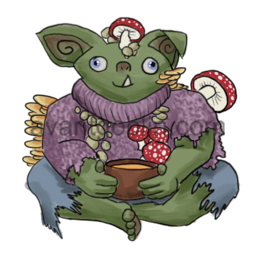 |
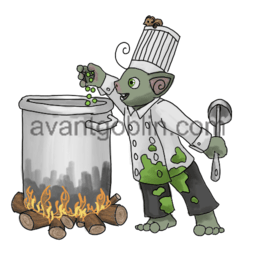 |
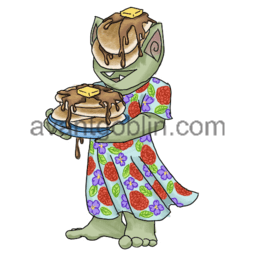 |
Cuisine
Goblins in general will eat just about anything they can get their hands on, fit in their mouth, and chew appropriately with rocks for teeth. When given space and a heat source, will continue to eat even more than that everything, if it can be chopped or boiled down to an edible level of soup... mostly. While goblins as a whole or a group will eat just about anything, individuals do have their favorites and preferences, and may turn up their nose at unwelcome snacks. They don't care much about dirt, bugs, or hair... will generally make some efforts to minimize, but not freak out if such things occur. Mold and rot also doesn't bother them much, and they're quite good at controlling spoilage to create excellent kimchi, pickles, cheese, kombucha, vinegar, mead, and the goblin-coveted "rat piss," an alcoholic beverage that is fermented inside a live, well-fed rat (to give it flavor). They also delight in simmering things, and as well as soups made of anything at all, will produce tea, coffee, jams, and preserves. Not extraordinarily gifted with containing smoke enough to do any good, they are fairly handy at sun-drying or slow-roasting things, including assorted fruits, tomatoes, and meats.
All of this is totally and completely on purpose and not at all to do with the forgetful nature of goblins combined with delight at finding forgotten things [HEAVILY IMPLIED SARCASM].
Preferred cuisine is found through foraging, primarily. Things can be foraged from the forests and caves, such as acorns, pinecones, mushrooms, nuts, berries, bugs, fish, and wild-growth roots and veggies. "Farming" tends to be limited and tends strongly towards the hardy and self-sufficient, such as squash, tomatoes, goats, and things which grow on trees; which are not so much farmed as "allowed to exist until edible." Things also can and will be foraged from other settlements and civilizations, from leftovers to by-products and everything in between. Though not in the business of any "bread" more complicated than "smashed acorns and water baked on a rock to form crackers," goblins love flour, bread, pastries, and sweets, and will pursue these if available; and legend has it that a goblin with a sufficient non-goblin support system could even be a baker of a sort. A goblin will rarely or never pay money for food, when there is always so much to be found in the wild and the garbage, and meals to be shared or borrowed.
Seasoning is even-odds, and can range from seawater brine as a soup base, foraged peppers and onions, or stolen seasoning popular with other civilizations nearby. They do love onions and garlic, as well as the flavors of vinegar and fermentation, and goblin cuisine can easily give an outsider bad breath for days (and quite likely severe indigestion).
Goblins do eat fairly often, and are great fans of snacks and drinks, but mostly only have one big meal a day, usually soup or a roasted something or other of the sort that takes all day to cook.
According to a survey of the sorts of people brave enough to eat goblins, their flavor is akin to a non-perishable canned or bagged meal, blended and reduced into a jello salad on the "bone", which is soft and gristly all the way through. Not recommended eating or high cuisine, but looks a lot more appealing on the far side of a long hike or dungeon crawl.
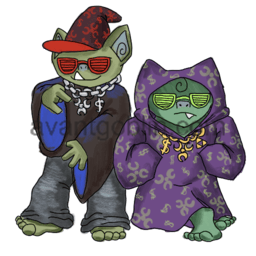 |
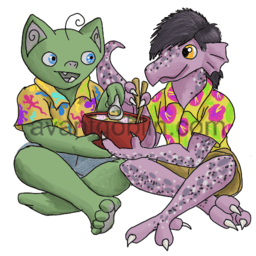 |
 |
Goblin Culture; Alone and Assimilated
Goblins can and will live in all-goblin settlements, but will happily adopt and co-mingle with anything non-hostile they come across. Some of these attempts go better than others; the local AvantGoblin colony has mingled with pixies, kobolds, gnomes, trolls, imps, poms, gremlins, and mushroom pygmies. Humans and other civilizations with hard laws and dignity tend to view goblins as invasive, an eyesore, and vermin-adjacent, digging through trash and screaming and hanging out with raccoons and other "lesser" creatures. This is a pervasive motif in a lot of human literature.
Goblins do prefer the term "opportunistic" to invasive. They're a quite effective clean-up species, taking things that are no longer wanted and giving them new life. They are on the whole loud and a bit rowdy, but not too much different than a large collective of human children, with silliness and bizarre rules that are specific yet meaningless, and can range from cartoon levels of goofy to remarkably well-read. They are always happy to go so far as adopting unwanted babies, and the biggest specified nusiance from settlements sporting a goblin colony is that goblins are not actually fantastic at discerning the exact point of "unwanted," and will walk off with everything from apples with a bruise to whole babies with grouchy sitters who wish them away.
Goblins do not have a native currency, and work primarily in either "you don't want this so it's mine now," or trade and barter. Just about anything is fair game for this, from snacks and ingredients, to useful items, to nest trinkets, even teeth (which are found rocks anyway). These trades are highly subjective based on the interest and negotiation of the other party. Goblins struggle to assimilate to more numerically based currencies, but do understand the concept of "swindled," and are thus notorious for theft, underpayment, and attempting to pay for things with buttons and sequins (which are shiny, and therefore quite valuable by all goblin accounts). This is likely the reason that goblins also have only one word for buy, borrow, lend, gift, steal, sell, and take from the trash... it's "steal". That being said, roving goblin merchants are quite likely to have some incredible merchandise on the higher end, and be quite happy to trade enchanted wares or gemstones for some acceptably interesting trinkets. Goblin merchants who work successfully with mixed-species populations long-term often have food trucks or limited inventories of very specific items for sale, with a value they can identify from a numeric currency, exact change only, over or under just gets you that many things.
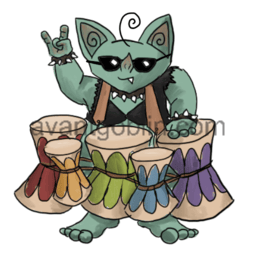 |
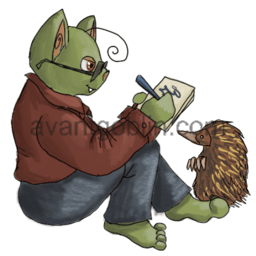 |
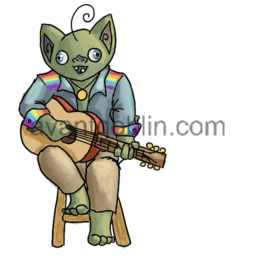 |
Art, Music, and Literature
Goblins, not having bones, are not especially dextrous; but they are better at smaller endeavors than large ones. Though smithing, agriculture, and architecture are out of reach, goblins will happily sing, draw, make pottery (to fill with tasty things, mostly), and most other creative endeavors they can find or imagine. Sewing is popular, but more so for large decorative stitching or patchwork over fairly utilitarian style choices, as it's difficult to create over-complex patterns or fine embroidery and lace with fat little fingers. Drawing is done for informational signs as well as decoration of spaces. Artwork in general tends to have some purpose, even if the purpose is "be shiny". No notable greatness on a worldwide scale comes from this, but there is a certain charm to it, popular with some collectors.
It is theorized that goblin music is less "music" on a notes and skill level, so much as it is using tools to make an incredible amount of noise and racket. This has never stopped anyone, and several all-goblin bands are quite popular in the punk and metal genres.
Goblin linguistics are, like most things they interact with, made of stolen and simplified bits of other things that have been come across and borrowed. The goblin "language" is indeed incomprehensible to most non-goblins, and can only be learned from a goblin, but is little more than a crazed pidgen, and easiest to use if the speaker has large and expressive ears or head decor (as many of the other AvantGoblin resident species sport). Literature often starts vocal, but quickly becomes corrupted and exaggerated with re-tellings. Most records are a favorite version of the "author" of whatever story, written down with its own quirky bastardization, but now slightly less likely to be re-corrupted... until it's read aloud. Most goblin literature that makes its way into the wider world does so by finding its way into the hands of children or people with an interest in things designed for children.
Additional Notes
Goblins are the primary study and interest of this operation. Other creatures have been adopted in, and have their own lore (upcoming!) but are not currently half so fleshed out for the most part. At this time, suggestions and consultation is quite likely to become lore canon; get in touch!
Goblins are not for everyone. They are a very particular flavor, and the AvantGoblin colony specifically an even more particular flavor than that. It is okay to have your own variety of goblins or anything else, and care for them in your own way... but if any of this sounds familiar or appealing, then adopt your own goblin! Or become one! And not just merch-wise, but embrace the lifestyle of being just a little messy and not great with the hands. Nothing matters except when dinner is!
